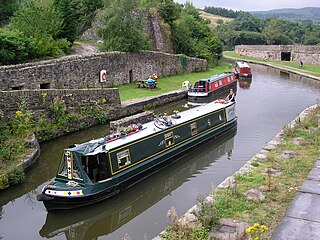
A narrowboat is a particular type of canal boat, built to fit the narrow locks of the United Kingdom. The UK's canal system provided a nationwide transport network during the Industrial Revolution, but with the advent of the railways, commercial canal traffic gradually diminished and the last regular long-distance transportation of goods disappeared in 1970. However, some commercial traffic continued. From the 1970s onward narrowboats were gradually converted into permanent residences or as holiday lettings. Today, approximately 6000 narrowboats are registered as permanent homes on Britain's waterway system and represent a growing alternative community living in semi permanent moorings or continuously cruising.
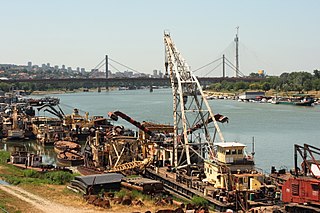
A riverboat is a watercraft designed for inland navigation on lakes, rivers, and artificial waterways. They are generally equipped and outfitted as work boats in one of the carrying trades, for freight or people transport, including luxury units constructed for entertainment enterprises, such as lake or harbour tour boats. As larger water craft, virtually all riverboats are especially designed and constructed, or alternatively, constructed with special-purpose features that optimize them as riverine or lake service craft, for instance, dredgers, survey boats, fisheries management craft, fireboats and law enforcement patrol craft.
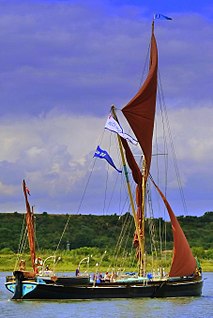
A Thames sailing barge is a type of commercial sailing boat once common on the River Thames in London. The flat-bottomed barges with a shallow draught and leeboards, were perfectly adapted to the Thames Estuary, with its shallow waters and narrow tributary rivers. The larger barges were seaworthy vessels, and were the largest sailing vessel to be handled by just two men. The average size was about 120 tons and they carried 4,200 square feet (390 m2) of canvas sail in six working sails. The mainsail was loose-footed and set up with a sprit, and was brailed to the mast when not needed. It is sheeted to a horse, as is the foresail; they require no attention when tacking. The foresail is often held back by the mate to help the vessel come about more swiftly.

Lake freighters, or lakers, are bulk carrier vessels that ply the Great Lakes of North America. These vessels are traditionally called boats, although classified as ships.

La Belle Epoque is a barge of the Belgian spits category. She was built in 1930 to carry (mainly) timber. Renovated in 1995, she operates as a hotel barge on the Burgundy Canal in central France.

A Dutch barge is a traditional flat-bottomed shoal-draught barge, originally used to carry cargo in the shallow Zuyder Zee and the waterways of Netherlands. There are very many types of Dutch barge, with characteristics determined by regional conditions and traditions.

Anjodi, was built to carry freight on the waterways of the Netherlands, Belgium and France but has been converted to a hotel barge.
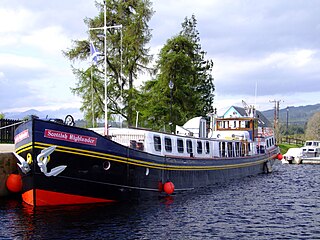
The Scottish Highlander is a boutique hotel barge cruising the Caledonian Canal in Scotland, from Inverness to Fort William. She is a Luxe motor Dutch steel barge. She is a member of the fleet of hotel barges owned by European Waterways.

The L'Impressionniste was built in 1960 in Belgium and is a spits barge with a Dutch luxe motor-style bow. The overall hull shape of the barge is a marriage of the French and Dutch barge building influences. She was converted to a hotel barge in 1996. L'Impressionniste is owned and operated by European Waterways and sails on the Canal de Bourgogne in France.
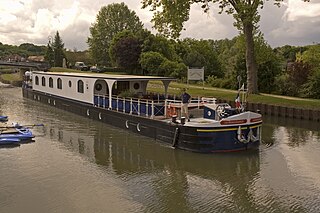
La Renaissance was built in Belgium in 1960 as a standard péniche barge to carry cargo along the canals of Europe. Her original cargo was grain and iron ore. She presently serves as a hotel barge, owned and operated by European Waterways. She is one of around 60 barges offering luxury cruises on French waterways.
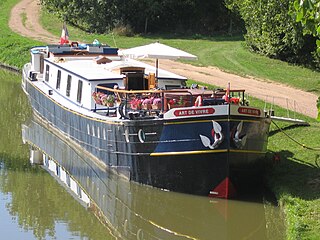
The L'Art de Vivre was built in 1917 in Deptford, England, as a cargo barge but currently serves as a luxury hotel barge owned and operated by European Waterways. She is one of around 60 hotel barges operating on European waterways, mostly on the smaller French canals.

The La Dolce Vita was built in 1897 in Groningen, Netherlands. She originally served as a cargo barge in the Netherlands. She presently serves as a hotel barge, owned by Giampaolo Friso.

A hulk was a type of medieval sea craft, a technological predecessor of the carrack and caravel. The hulk appears to have remained a relatively minor type of sailing ship apparently peculiar to the Low Countries of Europe where it was probably used primarily as a river or canal boat, with limited potential for coastal cruising. The only evidence of hulks is from legal documents and iconography.
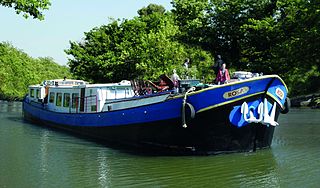
Rosa is a French hotel barge of Dutch origin. Since 1990 she has been offering cruises to international tourists on the Canal de Garonne in the Nouvelle Aquitaine region of South West France.. The waterway authority Voies Navigables de France reported in 2014 that there were around 80 hotel barges operating on the inland waterways. They keep alive the tradition of the boatmen (mariniers) who have declined in number from thousands in the post-World War II years to just a few hundred today.

MV Spirit of Chartwell is a hotel barge owned and operated by Portuguese holiday company Douro Azul for luxury cruises along the Douro river, Porto, Portugal.

Gloriana is a 90-foot-long (27 m) British royal barge. She was privately commissioned as a tribute to Queen Elizabeth II for her 2012 Diamond Jubilee, and was the lead vessel in the Thames Diamond Jubilee Pageant.
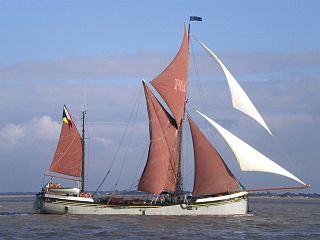
Will is a Thames sailing barge, built in Great Yarmouth by Fellows & Co in 1925. She is 97.6 ft (29.75 m) long, 23.1 ft (7.04 m) across and 9.6 ft (2.93 m) deep. Will Everard, as she was originally known, was commissioned as one of four steel barges; the largest ever built. She is a mulie, with a spritsail rigged mainmast, a topmast and a gaff-rigged mizzen. She has a flat bottom with leeboards as is customary for Thames sailing barges. As one of the last sailing cargo vessels to operate in UK waters she left trade in 1966. After a few years lying derelict, she was refitted and eventually entered into the service of P&O where she was used as a floating board room until 1999. This role in corporate hospitality continued and she now is fully engaged in private charter work. She currently operates out of the Pool of London from a base at Hermitage Community Moorings, Reeds Wharf and St Katherine Docks for cruises through London, the east coast and beyond.

The Luciole is a converted French barge, or péniche. She was built in 1926. In 1966 she became the first hotel barge on the French canal system. She now operates on the Canal du Nivernais and River Yonne, her home mooring is in Auxerre.

SB Centaur is a wooden Thames sailing barge, built in Harwich, Essex, England in 1895. She was used to carry various cargoes, mainly grain, for the next 60 years. During the First World War she carried food and coal to the French Channel ports. During the Second World War Centaur was damaged when sailing to assist with the Dunkirk Evacuation. She did war work for the duration of the conflict.

SS Robert Wallace was a wooden-hulled American bulk freighter that served on the Great Lakes of North America from her construction in 1882 to her sinking in 1902 on Lake Superior near the town of Palmers, St. Louis County, Minnesota, United States. On November 17, 1902 shortly after leaving Superior, Wisconsin with a cargo of iron ore, Robert Wallace sprang a leak and sank. Her wreck was found in 2006, and on October 14, 2009, the wreck of Robert Wallace was listed in the National Register of Historic Places.




















